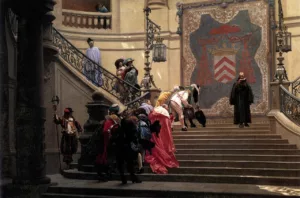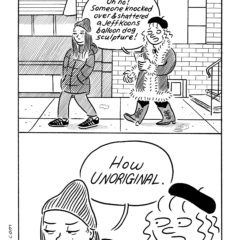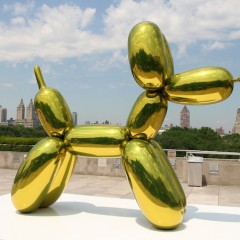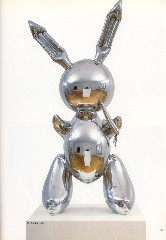
Rabbit, by Jeff Koons
The key words Jeff Koons delivered in has talk yesterday at the University of Pennsylvania–“I always loved sales.”
He still does. I felt from the beginning to the end like I was listening to one of those sales speils, in which the huckster makes leaps of illogic that sound almost right. He went back to memories of enjoying selling (what was he selling, chocolates to raise money for the team? subscriptions to Boy’s Life?) as he knocked on doors, awaiting the opening door. “You never knew what odor was going to come out.”
Is he kidding? How can you believe that to be a fond memory? It’s a creepy memory.
I mean, what are we to make of statements like “Sales are the front line of morality and society”? It’s meaningless.
Nonetheless, the talk made utter sense in terms of Koons’ oeuvre–the shiny objects of desire, the sexual innuendo in those objects when Koons is at his best. Even his practice of appropriation of kitsch seemed like a good fit to the spiel.
Koons’ sense of humor, which is clear in his art, also came out during the talk. He showed a picture of himself at the age of four with a set of crayons, stating he “probably had the most integrity as an artist then.” That evoked some titters from the stand-up crowd squeezed into B-1 at Meyerson Hall (I forgot to do the crowd count).
He made it clear in his talk that what he wanted more than anything was to break in and be famous even more than he wanted to make art. Koons’ double-dealing is in the tradition of Duchamp, an artist he refered to several times in his talk. Koons is funny, smart, witty. He’s not to be trusted one bit.
Koons gave the kids the solid gold pep talk–“Trust yourself, follow your instincts, things become metaphysical and it just takes care of itself.” What? metaphysical? Puleez. More sales.
I loved how he confessed that while he was working on Wall Street to support himself, he sold pieces for only $3,000 that cost him $20,000 to make.
I found it interesting that he spoke of influences from Jim Nutt, Ed Paschke and the Hairy Who.
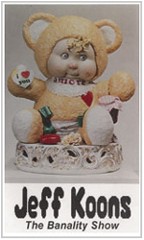
Amore, on a poster for the Banality show
Here are some more unreliable statements from him: “White middle class artists are using art for ethnic mobility.” He dismissed their work. He’s a white middle class artist, too (btw he said he grew up in Pennsylvania, in York). Another unreliable point: Ads “use luxury and abstraction to debase the audience.” Still another: “Ready-mades are a symbol for finding grace and acceptance in the world.” It’s one thing to make these statements and back them with proof, but he does no such thing. He’s glib, he talks fast and he hopes he’s pulling you right along with him.
He yacked on about how his work was always about maintaining the integrity of the object. What does that mean? Is it something different than any other artist making objects?
He also talked about hiring people who would normally carve statues for churches to make the kitschy sculptures of his “Banality” show. Then he said, “Kitsch is a judgment, and I don’t believe in any judgements.” He said he was all about acceptance, instead.

Michael Jackson and Bubbles
Of his Michael Jackson and Bubbles, which is made of porcelain, he said the piece is about how we regard a celebrity as a god. He compared the piece to the Pieta, but said it was less intimidating. This also evoked some titters. The Pieta is still sacred, I guess.
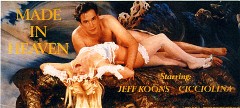
After showing his billboard, Made in Heaven, which was commissioned by the Whitney, he showed another piece of himself and Ilona (his ex who’s also pictured in Made in Heaven) in flagrante, the main subjects being her asshole and his penis entering her. He said it showed there were two ways into the eternal–the spiritual and the biological, the latter represented by Ilona’s asshole. Well what about his biological erect penis? And what eternal are we talking about? And what does spiritual mean in this context? Then he compared Made in Heaven to Manet’s Luncheon in the Grass. The crowd in the room giggled here. Why they weren’t having hysterics all along I cannot say.
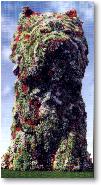
Puppy
In talking about Puppy, he went on about the 60,000 plants in the piece equaling 60,000 decisions. He talked about the order and control of the planting, and “then you just give it up.” The piece grows as it will. Then he said it was “a spiritual piece.” He also said it was about power, and showed everything he had leaned from the baroque and roccoco. That had to be part of the flim-flam operation, too.
He showed some more recent work, but there wasn’t much to look at. The early shiny work, the New pieces (think vacuum cleaners in vitrines), the Michael Jackson and Bubbles, and Puppy–those are great, and they are about the seduction of commodities (he said he tried to escape making pieces all about sex, and he was trying to make them more impersonal than that; I’d say he failed). But the best of the artwork is more than alluring and unreliable. It’s pretty damned smart.


